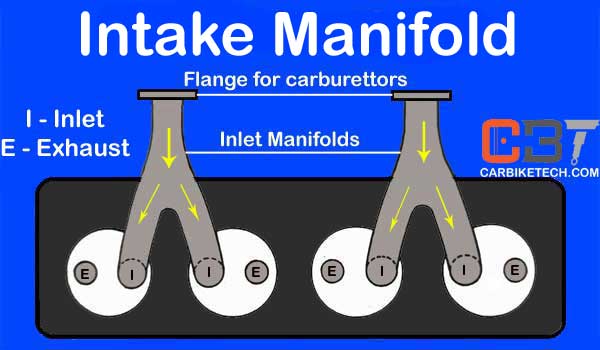Engine Intake System & Intake Manifold:
The intake system is one of the most critical engine systems. It deals with vehicle performance, such as power and torque. The multiple combustion chambers must produce equal combustion pressure for the smooth operation of a multi-cylinder engine. It is achievable if the charge going into the cylinders is of the same quantity. Besides, the charge’s quality, physical properties, and air-fuel ratio must be precisely the same. So, manufacturers pay special attention while designing the engine intake manifold.

Function:
A carburetor feeds the charge or air-fuel mixture to the engine. It mixes the fuel with the incoming air in correct proportions and supplies it to the engine. Intake manifold forwards and directs an equal amount of charge to cylinders. Proper valve timing allows the supply of an equal amount of charge to the cylinders, according to the firing order. Each piston compresses the charge equally as per the compression ratio. Correct ignition timing ensures the spark is fired at the right time to burn the charge completely. Therefore, the system maintains the equal combustion chamber pressure only when it meets the above conditions.
However, in reality, the quality & quantity of the charge supplied varies for all the cylinders. It is mainly because the intake manifold has different passage sizes, angles, contours, flow rates, temperatures, etc. Hence, there is a noticeable difference in the quality & quantity of the charge at low engine speeds.
Design:
The inlet/intake manifold consists of a cast iron or aluminum tube. Some modern manifolds are even powder coated or chrome plated. Manufacturers centrally mount the carburetor on the intake manifold. It carries the fresh charge from the carburetor to the intake valve ports. Manufacturers design the intake manifold in such a way that the air-fuel charge quickly reaches the engine cylinders. The carburetor sits on the inlet manifold. Manufacturers mount the intake manifold on the cylinder head/block depending on its design. However, it sits between the two cylinder banks in V engines.

A well-designed manifold has the shortest and smoothest path from carburetor to cylinders. Thus, it minimizes the condensation and collection of fuel on the manifold walls. Modern intake manifolds are heated to assist in the vaporization of the gasoline in the charge. The outgoing exhaust gases or the engine cooling system provide the heat for the purpose. In addition, a thermostat controls the heat. It deflects all the exhaust gases to heat the intake manifold when the engine is cold while supplying less heat when the engine warms up. Some designs also feature a hot spot where the fuel strikes the manifold walls.
Layout:
Single Pipe:
A single passage/single flange intake manifold has a single pipe that connects the carburetor to the engine cylinders directly. However, a twin or double flange manifold has two separate pipes for each pair of cylinders. Thus, in a four-cylinder engine, four passages, each from a cylinder, merge into one pipe which connects to the carburetor. For better distribution of air-fuel mixture, engineers ensure an approximately equal distance from the carburetor to each cylinder.
Duel Pipe:
Generally, dual/twin intake manifolds with two pipes have dual carburetors, one for each carburetor barrel. Each of these pipes feeds half of the total engine needs. Thus, it prevents the overlapping of the strokes in the manifold. Therefore, it improves the uniformity of the distribution of the air-fuel mixture.

Quad:
Furthermore, some modern engines feature a four-pipe design. In a four-pipe intake manifold, primary & secondary outlets for the same side of the carburetor lead to cylinders 2, 3, 5, and 8, while the other pipes lead to cylinders 1, 4, 6, and 7.

In conclusion, designing a perfect manifold is a must while manufacturing it on a mass scale. Weapon-R, Holley, Edelbrock, and Banks are some of the intake manifold manufacturers.
Read More: How does the Engine Exhaust system work?>>
